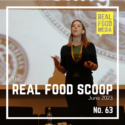by Anna Lappé
McDonald’s is having a bumpy year. It just installed a new CEO after a mere two-and-a-half-year stint by his predecessor. In January it announced its latest returns — and the news was bad. It included such shareholder downers as a “global comparable sales decrease of 1 percent, reflecting negative guest traffic in all major segments.” Last month the business press reported that the Gates Foundation divested $1 billion in stock from the company last quarter. While the stock divestment doesn’t affect McDonald’s bottom line, it does affect its reputation: McDonald’s is stumbling.
In the face of this string of bad news, McDonald’s appears to be having a brand identity crisis and pouring PR money on its problems instead of addressing head-on their causes: a growing disinclination, especially among millennials, to support a company renowned for its ill treatment of workers, predatory marketing to kids and questionable food sourcing.
Struggling for Relevance
Millennials — 20- and early-30-somethings — are turning their backs on the brand. From 2011 to the end of 2014, the percentage of 19-to-21-year-olds visiting McDonald’s fell nearly 13 percent. As an August 2014 Fortune headline put it, “McDonald’s struggling to stay relevant with millennials.”
They are flocking elsewhere for a number of reasons. They came of age in a time with a lot more fast-casual options than previous generations could have anticipated — options that are better tasting, higher quality and still affordable. (Chipotle, anyone?) They’re turning to other brands that reflect more of their concerns with the environment, workers’ wages and animal welfare. Instead of listening to these concerns, McDonald’s is turning to PR spin to solve its problems.
While a diverse bunch, many millennials are more engaged in environmental and social causes than young people have been for a long time. In one recent poll, two-thirds of millennials said they would vote for a candidate who supports cutting greenhouse gas emissions, compared with just half of Americans over 65. Millennials have been on the front lines of some of the biggest environmental fights of our time, from the Keystone XL pipeline battle to the 450,000-person People’s Climate March in New York City last year.
They are a leading force in the good food movement, with national networks such as Real Food Challenge, which was founded just a few years ago and now enlists tens of thousands of college students to push for better food on college campuses, and Food Corps, a national AmeriCorps training program that fosters youth school garden educators. Books such as Michael Pollan’s “The Omnivore’s Dilemma,” films like “Food Inc.” and advocacy groups such as Food & Water Watch are inspiring young people to ask questions about where their food comes from and raise hell about antibiotics and hormones in meat.
Millennials are passionate about workers’ rights and income inequality, evidenced by the dynamism of Occupy Wall Street and the fight for a fair wage that heated up around the country last year in actions such as the Fight for $15. From its poor pay to its wasteful packaging to its sourcing of climate-destructive industrial meat and dairy, McDonald’s doesn’t represent labor-friendly, sustainable or healthy practices.
So if not to McDonald’s, where are millennials headed? Those who have the disposable income to do so are pulling up a stool at Chipotle, diving into a burger at Shake Shack or grabbing a sandwich at Panera Bread. In short, many are spending their money at fast-casual establishments, which saw a 2.3 percent jump among 19-to-21-year-olds and a 5.3 percent increase among 22-to-37-year-olds from 2011 to the end of 2014. Fast-casual restaurants show continuing signs of strong growth. Since Chipotle went public in 2006, “its stock price has risen more than 1,500 percent,” James Surowiecki wrote last month in The New Yorker.
While Chipotle and Shake Shack shouldn’t be confused with health food joints — a steak burrito from Chipotle can load you with 1,290 calories, and a double ShackBurger have 770 calories and your daily recommended dose of sodium — these chains arguably produce better-tasting food and have made explicit commitments to sourcing better ingredients. Shake Shack owner Danny Meyer, for instance, has promised to use only meat raised without hormones and antibiotics. Many of these restaurants offer better benefits and pay than McDonald’s does. Take Shake Shack’s starting hourly wage of $10 in New York City; it’s still not going to get a family of four out of poverty, but it’s better than the minimum wage.
Flailing Tactics
McDonald’s is trying desperately to lure back millennials. In its one nod to the priorities of this generation, it released a request for proposal late last year for media companies to develop “a big idea” that “generates significant support for a charity” and “engages millennials to support this charity by speaking directly to their philanthropic priorities and leveraging their behaviors and habits,” according to information obtained by The Wall Street Journal.
But mostly the company has been launching a host of new PR campaigns leading to schizophrenic positioning and mixed results. In January, USA Today reported that McDonald’s opened a café in Australia with healthy offerings on the menu and nary a Golden Arch in site, about the same time that it launched a TV spot bragging about old-school Big Macs unchanged by foodie influences. (Kale, quinoa, and soy were all name-checked — and mocked.) Last year saw the rebranding flop of both its iconic Ronald McDonald mascot and the Happy Meal, which set off a social media firestorm as young people around the world mocked the new creepy, toothy look.
It’s trying hard to be hip too, setting up shop last year in San Francisco to incubate digital strategies. The new office, based in the hotbed of digital disruption, will help the company be “more plugged into the flow of ideas,” said the company’s Chief Digital Officer Atif Rafiq. But as one Forbes commentator quipped, “All the talk about digital tech isn’t disruptive, it’s predictably also-ran.”
Last year McDonald’s tried to make a splash with its new dynamic in-store kiosk that lets customers customize their burgers. After spending big on the launch, McDonald’s had to rebrand it from Build Your Own Burger to Create Your Taste because it added chicken to the menu. Oops. It also launched what it calls Experience the Future, “a comprehensive restaurant execution concept” that “capitalizes on investments in reimaging, service and technology enhancements to improve the look, feel and convenience of the McDonald’s experience in ways that are in-tune with today’s consumer needs.” Which sounds more like PR gobbledygook than a serious attempt to rethink the chain.
These missteps, just a few signs of the company’s flailing, are reflected in weak earnings reports and personnel trouble at the top, with significant turnover in key positions. Two McDonald’s USA presidents, President and CEO Jim Skinner, Chief Marketing Officer Neil Golden and Chief Operating Officer Tim Fenton were replaced in the past several years. The trend continues with the early retirement of CEO Don Thompson late last month.
Walmart’s recent announcement that it will increase the wages for its lowest-paid workers makes it ever clearer that McDonald’s is out of step with the rest of retail. It’s time for McDonald’s to give people a reason to love it — and not just throw money at advertisements that tell us we should.
Postscript: Sounds like the new CEO might have gotten the memo. In an announcement today, McDonald’s committed to only “sourcing chicken raised without antibiotics that are important to human medicine.” It’s a step the company took after seven months of dialogue and concerted pressure from civil society groups, including Friends of Earth. The environmental organization’s senior program manager, Kari Hamerschlag, said in a press release, “While McDonald’s focus on poultry is a positive step forward, we look forward to a dramatic reduction of antibiotic use across the board, by focusing on improvements in their pork and beef suppliers’ management practices.” McDonald’s announcement makes it the largest restaurant chain in the country to adopt such a policy.
Originally published in Al Jazeera America
Photo by Beth Wiki/Wikimedia




